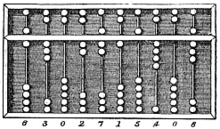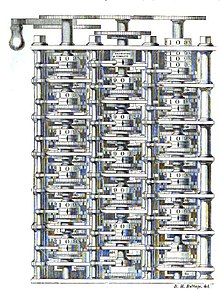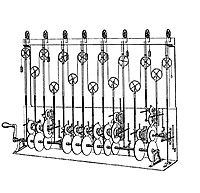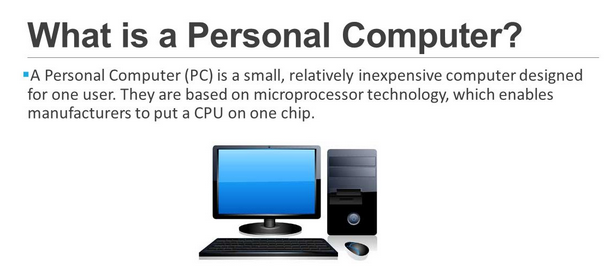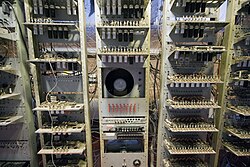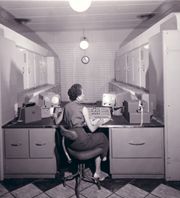Pre-twentieth century
The Ishango bone
Devices have been used to aid computation for thousands of years, mostly using one-to-one correspondence with fingers. The earliest counting device was probably a form of tally stick. Later record keeping aids throughout the Fertile Crescent included calculi (clay spheres, cones, etc.) which represented counts of items, probably livestock or grains, sealed in hollow unbaked clay containers.[3][4] The use of counting rods is one example.
The Chinese Suanpan (算盘) (the number represented on this abacus is 6,302,715,408)
The abacus was initially used for arithmetic tasks. The Roman abacus was developed from devices used in Babylonia as early as 2400 BC. Since then, many other forms of reckoning boards or tables have been invented. In a medieval European counting house, a checkered cloth would be placed on a table, and markers moved around on it according to certain rules, as an aid to calculating sums of money.
The ancient Greek-designedAntikythera mechanism, dating between 150 and 100 BC, is the world’s oldest analog computer.
The Antikythera mechanism is believed to be the earliest mechanical analog “computer”, according to Derek J. de Solla Price.[5] It was designed to calculate astronomical positions. It was discovered in 1901 in the Antikythera wreck off the Greek island of Antikythera, between Kytheraand Crete, and has been dated to circa 100 BC. Devices of a level of complexity comparable to that of the Antikythera mechanism would not reappear until a thousand years later.
Many mechanical aids to calculation and measurement were constructed for astronomical and navigation use. The planisphere was a star chart invented by Abū Rayhān al-Bīrūnī in the early 11th century.[6] The astrolabe was invented in theHellenistic world in either the 1st or 2nd centuries BC and is often attributed toHipparchus. A combination of the planisphere and dioptra, the astrolabe was effectively an analog computer capable of working out several different kinds of problems in spherical astronomy. An astrolabe incorporating a mechanical calendar computer[7][8] and gear-wheels was invented by Abi Bakr of Isfahan, Persia in 1235.[9] Abū Rayhān al-Bīrūnī invented the first mechanical geared lunisolar calendar astrolabe,[10] an early fixed-wired knowledge processing machine[11] with a gear train and gear-wheels,[12] circa1000 AD.
The sector, a calculating instrument used for solving problems in proportion, trigonometry, multiplication and division, and for various functions, such as squares and cube roots, was developed in the late 16th century and found application in gunnery, surveying and navigation.
The planimeter was a manual instrument to calculate the area of a closed figure by tracing over it with a mechanical linkage.
The slide rule was invented around 1620–1630, shortly after the publication of the concept of the logarithm. It is a hand-operated analog computer for doing multiplication and division. As slide rule development progressed, added scales provided reciprocals, squares and square roots, cubes and cube roots, as well astranscendental functions such as logarithms and exponentials, circular andhyperbolic trigonometry and other functions. Aviation is one of the few fields where slide rules are still in widespread use, particularly for solving time–distance problems in light aircraft. To save space and for ease of reading, these are typically circular devices rather than the classic linear slide rule shape. A popular example is theE6B.
In the 1770s Pierre Jaquet-Droz, a Swiss watchmaker, built a mechanical doll (automata) that could write holding a quill pen. By switching the number and order of its internal wheels different letters, and hence different messages, could be produced. In effect, it could be mechanically “programmed” to read instructions. Along with two other complex machines, the doll is at the Musée d’Art et d’Histoire of Neuchâtel, Switzerland, and still operates.[13]
The tide-predicting machine invented by Sir William Thomson in 1872 was of great utility to navigation in shallow waters. It used a system of pulleys and wires to automatically calculate predicted tide levels for a set period at a particular location.
The differential analyser, a mechanical analog computer designed to solve differential equations by integration, used wheel-and-disc mechanisms to perform the integration. In 1876 Lord Kelvin had already discussed the possible construction of such calculators, but he had been stymied by the limited output torque of the ball-and-disk integrators.[14] In a differential analyzer, the output of one integrator drove the input of the next integrator, or a graphing output. The torque amplifier was the advance that allowed these machines to work. Starting in the 1920s, Vannevar Bush and others developed mechanical differential analyzers.
First computing device
A portion of Babbage’s Difference engine.
Charles Babbage, an English mechanical engineer and polymath, originated the concept of a programmable computer. Considered the “father of the computer“,[15]he conceptualized and invented the first mechanical computer in the early 19th century. After working on his revolutionary difference engine, designed to aid in navigational calculations, in 1833 he realized that a much more general design, anAnalytical Engine, was possible. The input of programs and data was to be provided to the machine via punched cards, a method being used at the time to direct mechanical looms such as the Jacquard loom. For output, the machine would have a printer, a curve plotter and a bell. The machine would also be able to punch numbers onto cards to be read in later. The Engine incorporated an arithmetic logic unit, control flow in the form of conditional branching and loops, and integratedmemory, making it the first design for a general-purpose computer that could be described in modern terms as Turing-complete.[16][17]
The machine was about a century ahead of its time. All the parts for his machine had to be made by hand — this was a major problem for a device with thousands of parts. Eventually, the project was dissolved with the decision of the British Government to cease funding. Babbage’s failure to complete the analytical engine can be chiefly attributed to difficulties not only of politics and financing, but also to his desire to develop an increasingly sophisticated computer and to move ahead faster than anyone else could follow. Nevertheless, his son, Henry Babbage, completed a simplified version of the analytical engine’s computing unit (the mill) in 1888. He gave a successful demonstration of its use in computing tables in 1906.
Analog computers
Sir William Thomson‘s third tide-predicting machine design, 1879–81
During the first half of the 20th century, many scientific computing needs were met by increasingly sophisticated analog computers, which used a direct mechanical or electrical model of the problem as a basis for computation. However, these were not programmable and generally lacked the versatility and accuracy of modern digital computers.[18] The first modern analog computer was a tide-predicting machine, invented by Sir William Thomson in 1872. The differential analyser, a mechanical analog computer designed to solve differential equations by integration using wheel-and-disc mechanisms, was conceptualized in 1876 by James Thomson, the brother of the more famous Lord Kelvin.[14]
The art of mechanical analog computing reached its zenith with the differential analyzer, built by H. L. Hazen and Vannevar Bush at MIT starting in 1927. This built on the mechanical integrators of James Thomson and the torque amplifiers invented by H. W. Nieman. A dozen of these devices were built before their obsolescence became obvious. By the 1950s the success of digital electronic computers had spelled the end for most analog computing machines, but analog computers remained in use during the 1950s in some specialized applications such as education (control systems) and aircraft (slide rule).
Digital computers
Electromechanical
By 1938 the United States Navy had developed an electromechanical analog computer small enough to use aboard asubmarine. This was the Torpedo Data Computer, which used trigonometry to solve the problem of firing a torpedo at a moving target. During World War II similar devices were developed in other countries as well.
Early digital computers were electromechanical; electric switches drove mechanical relays to perform the calculation. These devices had a low operating speed and were eventually superseded by much faster all-electric computers, originally using vacuum tubes. The Z2, created by German engineer Konrad Zuse in 1939, was one of the earliest examples of an electromechanical relay computer.[19]
In 1941, Zuse followed his earlier machine up with the Z3, the world’s first workingelectromechanical programmable, fully automatic digital computer.[20][21] The Z3 was built with 2000 relays, implementing a 22 bit word length that operated at a clock frequency of about 5–10 Hz.[22] Program code was supplied on punched film while data could be stored in 64 words of memory or supplied from the keyboard. It was quite similar to modern machines in some respects, pioneering numerous advances such asfloating point numbers. Rather than the harder-to-implement decimal system (used in Charles Babbage‘s earlier design), using a binary system meant that Zuse’s machines were easier to build and potentially more reliable, given the technologies available at that time.[23] The Z3 was Turing complete.[24][25]
Vacuum tubes and digital electronic circuits
Purely electronic circuit elements soon replaced their mechanical and electromechanical equivalents, at the same time that digital calculation replaced analog. The engineer Tommy Flowers, working at the Post Office Research Station in London in the 1930s, began to explore the possible use of electronics for the telephone exchange. Experimental equipment that he built in 1934 went into operation 5 years later, converting a portion of the telephone exchange network into an electronic data processing system, using thousands of vacuum tubes.[18] In the US, John Vincent Atanasoff and Clifford E. Berry of Iowa State University developed and tested the Atanasoff–Berry Computer (ABC) in 1942,[26] the first “automatic electronic digital computer”.[27] This design was also all-electronic and used about 300 vacuum tubes, with capacitors fixed in a mechanically rotating drum for memory.[28]
Colossus was the first electronicdigital programmable computing device, and was used to break German ciphers during World War II.
During World War II, the British at Bletchley Park achieved a number of successes at breaking encrypted German military communications. The German encryption machine, Enigma, was first attacked with the help of the electro-mechanicalbombes. To crack the more sophisticated German Lorenz SZ 40/42 machine, used for high-level Army communications, Max Newman and his colleagues commissioned Flowers to build the Colossus.[28] He spent eleven months from early February 1943 designing and building the first Colossus.[29] After a functional test in December 1943, Colossus was shipped to Bletchley Park, where it was delivered on 18 January 1944[30] and attacked its first message on 5 February.[28]
Colossus was the world’s first electronic digital programmable computer.[18] It used a large number of valves (vacuum tubes). It had paper-tape input and was capable of being configured to perform a variety of boolean logical operations on its data, but it was not Turing-complete. Nine Mk II Colossi were built (The Mk I was converted to a Mk II making ten machines in total). Colossus Mark I contained 1500 thermionic valves (tubes), but Mark II with 2400 valves, was both 5 times faster and simpler to operate than Mark 1, greatly speeding the decoding process.[31][32]
ENIAC was the first Turing-complete device, and performed ballistics trajectory calculations for the United States Army.
The US-built ENIAC[33] (Electronic Numerical Integrator and Computer) was the first electronic programmable computer built in the US. Although the ENIAC was similar to the Colossus it was much faster and more flexible. Like the Colossus, a “program” on the ENIAC was defined by the states of its patch cables and switches, a far cry from the stored program electronic machines that came later. Once a program was written, it had to be mechanically set into the machine with manual resetting of plugs and switches.
It combined the high speed of electronics with the ability to be programmed for many complex problems. It could add or subtract 5000 times a second, a thousand times faster than any other machine. It also had modules to multiply, divide, and square root. High speed memory was limited to 20 words (about 80 bytes). Built under the direction of John Mauchly and J. Presper Eckert at the University of Pennsylvania, ENIAC’s development and construction lasted from 1943 to full operation at the end of 1945. The machine was huge, weighing 30 tons, using 200 kilowatts of electric power and contained over 18,000 vacuum tubes, 1,500 relays, and hundreds of thousands of resistors, capacitors, and inductors



